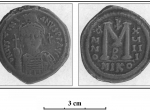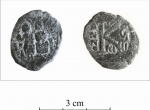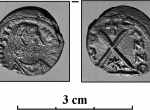Follis
Follis (Latin: bag, leather pouch) a bronze monetary unit introduced with the coinage reform of Diocletian in late 3rd c., see also →Solidus, minted in the Byzantine Empire until late 11th c. The year 498, time of the monetary reform of Emperor Anastasius, is treated as a dividing line between Late Roman and Byzantine coinage.
In 4th-5th cc. bronze coinage (Æ), at first washed with silver, underwent many changes; the follis introduced by Diocletian weighed more than 10 grams but with time, owing to reductions, its weight continued to decrease. In reference literature Late Roman bronze coins are conventionally distinguished by size into four groups: Æ 1 – Æ 4, the latter especially described as minimi.
With the thorough reform of bronze coinage made by Emperor Anastasius in 498 the follis was established as a legitimate monetary unit. Bronze coins put into circulation at this time were described using the number of nummi (singular nummus), which corresponded to units of account, but were rarely minted as coins. On the reformed bronze coins the number of nummi was given in Greek (Figs. 1-3): follis – M = 40 nummi, half-follis – K = 20 nummi, decanummium – I = 10 nummi. In 512 the weight of all these denominations was doubled (that of the follis from 9.10 g to 18.19 g), and next increased by Justinian (527-565): after the reform of 538/539 the follis weighed 24.26 g. The weight of these bronze coins was subsequently reduced repeatedly during the 6th c. These frequent changes presumably were dictated by the wish to adjust the value of the bronze coins to the changing real value of the gold coins. Starting from 498 the obverse image was that of the emperor shown in profile; starting from 538/539 the ruler was shown – similarly as on the solidi →Solidus – in a frontal presentation: helmeted, diademed, cuirassed, with an orb topped with a cross, and shield. The reform of 538/539 also introduced the practice of marking on the reverse of the follis and its fractions the year of the imperial reign in which the coin was struck. This fact and the presence of mint marks make Earl Byzantine bronze coin finds a valuable historical source, easy to date and provenance.
Follis finds play an important role in the study of Late Antiquity in the Balkans and the Near East. Numerous bronze coin hoards from the Balkans traditionally are interpreted as evidence of Avar and Slav plundering expeditions; in a different concept F. Curta has drawn attention to the role of inflation in the process of thesaurisation of bronzes. The decreasing number of late 6th and early 7th c. finds of folles and fractions observed in Late Antique settlements indicates a gradual decline of urban life in the Balkans.
Bronze coinage found its way to Barbaricum both in 4th-5th c. and after the reform of 498. It is notable that 6th and 7th century folles are heavy and large coins (the heaviest, Justinian I issues, over 40 mm in diameter) and may have been regarded as more trustworthy by barbarians than the earlier minimi. It is also significant that large coins are easier to detect by archaeologists and amateurs. Finds of 6th and 7th century folles are relatively common in the continental Barbaricum but are not noted in Scandinavia and Britain.
Finds of 6th-7th century folles and fractions from Poland – 20 or so (see Fig. 4) - cluster in south-eastern Poland. This is also the area with the earliest archaeological evidence on Slav settlement. Nevertheless, the association of the folles with early Slav settlement is rather problematic.
The influx of the follis and its fractions to Central Europe declines around mid-7th century, not the least due to the economic crisis in the Byzantine Empire. The latest issues known from Poland are folles of Justinian II (issued 685-695) discovered in 2011 at Tałty in Mazuria, on the territory of the →Olsztyn Group .
MW
Literature: W. Hahn, Moneta Imperii Byzantini, Wien 1973, 1975, 1981, vol. I-III; M. Hendy, Studies in the Byzantine Monetary Economy c. 300-1450, Cambridge 1985; M. Salamon, Mennictwo bizantyńskie, Kraków 1987; J. P. C. Kent, Roman Imperial Coinage, vol. X, The Divided Empire and the Fall of the Western Parts, London 1994; W. Hahn, M. A. Metlich, Money of the Byzantine Empire, Wien 2000; C. Morrisson, V. Popović, V. Ivanišević et coll., Le Trésors monétaires des Balkans et d’ Asie Mineure (491-713), Paris 2006; M. Wołoszyn (ed.), Byzantine Coins in Central Europe between the 5th and 10th century, Kraków 2009.
-
 full resolution
full resolution
Fig. 1. Besko, woj. podkarpackie, Poland. Follis (40 nummi) of Justinian I; Nicomedia; 543/544, possibly 547 (Photo M. Wołoszyn).
-
 full resolution
full resolution
Fig. 2. Hlinsko, okr. Chrudim, Czech Republic. Half-follis (20 nummi) of Justinian II, Nicomedia; 572-573; (Photo J. Militký).
-
 full resolution
full resolution
Fig. 3. Łódź, woj. łódzkie, Poland. Decanummium of Justin II; Carthage; 565/566 (Photo M. Wołoszyn).
-
![Fig. 4. Early Byzantine coin finds from Poland, 6th-7th cc. [later than 518]; bronze coins are marked green (according to M. Wołoszyn).](http://www.mpov.uw.edu.pl/userfiles/pl/generated/thumbs/150x110_1/Badania/Thesaurus/follis4.jpg) full resolution
full resolution
Fig. 4. Early Byzantine coin finds from Poland, 6th-7th cc. [later than 518]; bronze coins are marked green (according to M. Wołoszyn).


